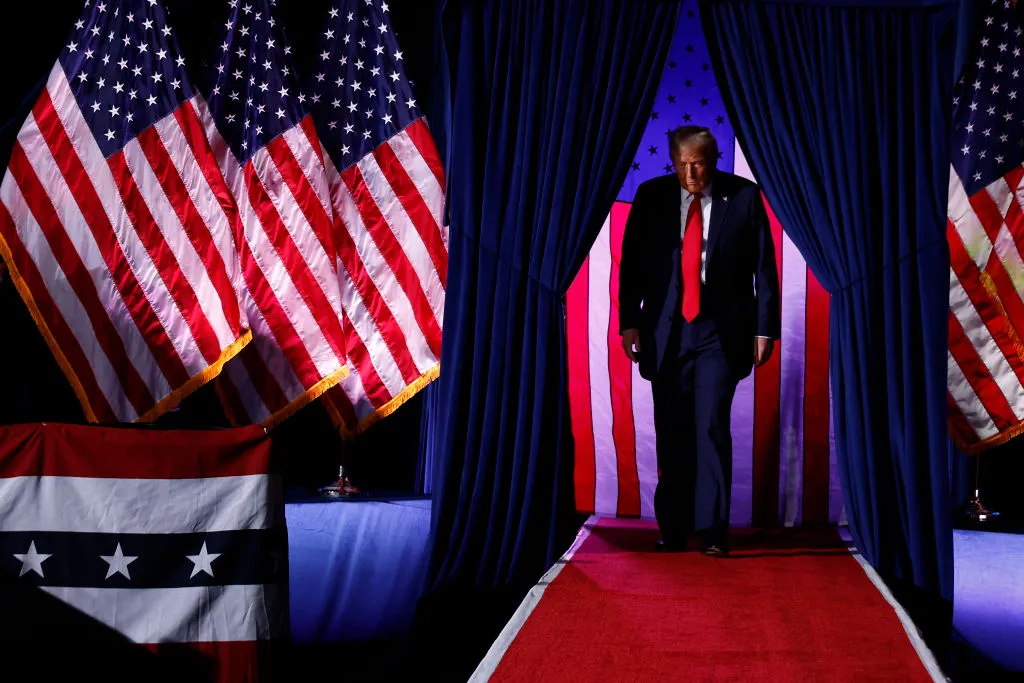
On November 6, 2024, the world woke up to a second Donald Trump presidency. Since the moment the race was called, legions have taken to social media to lament, rejoice, or just wonder what comes next. Some residents of the art world—artists, critics, curators, institutions—are asking the same.
Based solely on precedent, the near future appears to be grim. The 2016 Trump presidency was disastrous for arts funding, diversity, and education. He issued a travel ban on seven majority-Muslim countries that blocked entry for artists and arts professionals, to the outrage of the museum and university sector. Trump repeatedly attempted to defund federal arts funding; his 2018 and 2021 proposed budgets included the outright elimination of the National Endowment for the Arts (its budget in 2021 was $167.5 million, markedly low for a federal agency). The Corporation for Public Broadcasting, which partially funds PBS and NPR, and the Institute of Museum and Library Services were also targets. The cultural sector, already battling for crumbs with the Trump agency, took a blow during the Covid-19 pandemic and has yet to fully recover.
Facing four more years of antagonist cultural policy (and the outright antagonism of people and places that do not align with Trump’s values), the art stars came out en masse for Kamala Harris. Jeff Koons, Jenny Holzer, Simone Leigh, and nearly 200 more marquee talents donated works for a campaign fundraising auction that ultimately netted some $1.5 million. Carrie Mae Weems lent imagery from her seminal “Kitchen Table” series for a short film titled Kamala’s Table. Artist Brian Andrew Whiteley even got his viral “Trump Tombstone” sculpture out of retirement.
Their efforts, however, couldn’t carry Harris to the Oval Office. “45 years of unchecked Reaganism come crashing to an end replaced not by something humane but instead by something even more vile,” critic Siddhartha Mitter wrote on Instagram. He continued to echo a popular feeling about this election—that there was no moral presidential candidate in 2024, “just lesser evils that were inherently blunted by the flow of daily images of unspeakable US sponsored-horror in Palestine.”
Writer Rebecca Solnit called for resistance. “They want you to feel powerless and surrender and let them trample everything and you are not going to let them,” she wrote on X. “You are not giving up, and neither am I. The fact that we cannot save everything does not mean we cannot save anything and everything we can save is worth saving.” On Instagram, Forge Project, an Indigenous-led artist initiative in the Hudson, reiterated that it was a day for mourning, but also “a time to remember that we have strength in community.”
“It may mean the way we support people and the way we organize changes, but the election results make our work even more necessary. The somber reality of the settler state is an affirmation of the need for our collective dreaming and building,” Sarah Biscarra Dilley, Forge director of Indigenous Programs & Relationality, added.
As of Wednesday afternoon, few leading cultural institutions in the country have explicitly addressed the election results on social media. The Museum of Contemporary Art (MOCA) in Los Angeles, posted an archival image of the “Temporary Contemporary” south wall plastered with Barbra Kruger’s Untitled (Questions), from 1989–90. “Who is Beyond The Law? Who is Bought and Sold,” the text-based installation begins. Topical Cream, a New York-based arts organization that centers women and gender-nonconforming artists and arts education, wrote that its team was “more committed than ever” to its mission.
One of the primary concerns in this election was abortion rights, specifically following a 2022 Supreme Court decision that unraveled Roe v. Wade, which had guaranteed American citizens a constitutional right to an abortion since 1973. “Nothing in a country that has demonstrated over and over again that it values violence over education, profit over people, harm over healthcare, surprises me,” curator Jasmine Wahi wrote. “Call me a pessimist or realist, or just call me an American Woman.” The silver lining, in part, she added was that those most likely to suffer under a Trump presidency have known the “precarity” of “not being White Cis Het Male” in America.
Artists, of course, have also weighed in. Henry Taylor reposted a message from Dread Scott that partially reads, “The problem is not the election result. The problem is that people were voting on the best way to run an empire that is founded on slavery and genocide and is based on exploitation and oppression.”
Cauleen Smith shared a breakdown of Black, white, and Latino voters (“all other races” voted 42 percent Trump, 55 percent Harris). Some 81 percent of Black men and 90 percent of Black women voted for Harris. “Black people spent over 100 years trying to teach our oppressors how to cultivate an ethical core,” Smith wrote.
“Democrats refused to listen to their constituency,” she added. “They bent over for billionaires. Billionaires only get one vote (as of now at least). And they sold us out. Again. In the most painful of ways. Using our dreams against us.”
Yesterday, rafa esparza, an artist known for politically incisive projects, shared images from his performance bust: indestructible columns, set in the Ellipse, a 52-acre park south of the White House fence. In it, esparza climbs atop and into the hutch of a column, only to chip the stone loose, symbolically freeing himself from the confines of American white supremacy and its favored aesthetic, neoclassicism. Today, he shared the voter breakdown of Latino men (54 percent for Trump) and women (61 percent for Harris) with the message that there is “much to reflect on” when looking at these numbers.
“Let’s not forget about the pursuit of the American dream, (proximal to aspiring towards whiteness) which really needs to be demystified and demythologized for the actual horror that this pursuit entails for most people that are not white men and many just trying to exist in this country,” esparza wrote.
New York Magazine art critic Jerry Saltz, tweeting minutes after midnight, simply said, “When all were false I found you to be true. I love you all. All of this was worth the fight.”

